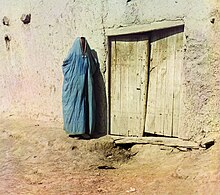Paranja


Paranja (or Paranji) is a traditional Central Asian robe of women and girls, that covers the head and body. It is also known as burqa in other languages. It is similar in basic style and function to other regional styles such as the Afghan chadari.
The part that covered the face, known as the chachvan (or chachvon), was heavy in weight and made from horsehair. It was especially prevalent among urban Uzbeks and Tajiks.
Paranji and chachvon were by 1917 common among urban Uzbek women of the southern river basins. Less frequently in the rural areas, but scarcely at all on the nomadic steppe. [1]
Russia's October Revolution encouraged a liberation of women, and sought to discourage or ban the veil, as well as the paranja.[2]
Gallery
References
- ^ Northrop 2001, p. 198
- ^ "Background: Women and Uzbek Nationhood". Human Rights Watch. Retrieved 16 September 2010.
Further reading
- Northrop, Douglas (2001). "Nationalizing Backwardness: Gender, Empire, and Uzbek Identity". In Suny, Ronald Grigor; Martin, Terry (eds.). State of Nations: The Soviet State and Its Peoples. Oxford University Press. pp. 191–220. ISBN 978-1-234-56789-7.
{{cite book}}: Invalid|ref=harv(help) - Northrop, Douglas (2003). Veiled Empire: Gender and Power in Stalinist Central Asia. Cornell University Press. ISBN 978-0801488917.
External links
For analysis of and discussion of the function of the robes, and for photos of such robes, see:
| Part of a series on |
| Islamic female dress |
|---|
| Types |
| Practice and law by country |
| Concepts |
| Other |


